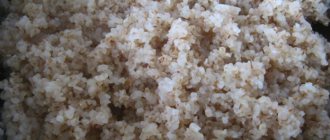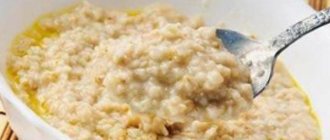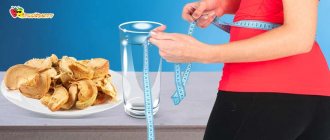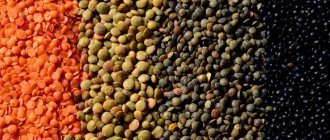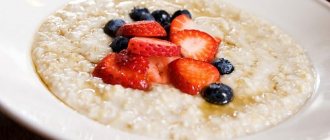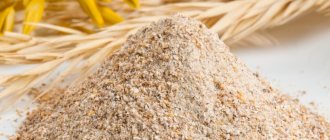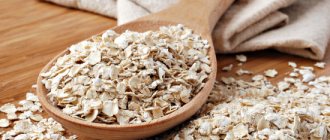How to choose wheat, rice or barley couscous
To get the maximum benefit from introducing it into your daily menu, you need to choose it carefully .
Today, there are many varieties in stores, and some of them are made on the basis of not only traditional flour, but also flour based on whole grains (when grinding it is not cleaned, but completely preserves the grain germ, endosperm, and husk).
The last option is more natural, healthier, contains almost 2 times more protein and fiber, although it will cost more.
Other recommendations for selection:
- When buying cereal, pay attention to its composition on the packaging. It is often made from not only durum wheat, but also barley or rice;
- Check to see if the product contains any unwanted artificial additives. The ideal one contains only two components: cereal (the type of flour/cereal from which it is made is indicated on the packaging) and water;
- try to choose cereals in completely sealed packaging: they quickly absorb unwanted odors and moisture;
- if you constantly don’t have enough time to cook, buy steamed cereal, which cooks surprisingly quickly;
- Stores in Arab countries often sell unsteamed couscous or its exclusive handmade analogue. Homemade cereals are stored for only a short time - a month or two. For long-term storage, it is better to take a well-dried and crumbly product.
How to choose couscous in a store:
The benefits and harms of couscous on a diet
Like any other product, couscous has a number of beneficial properties and contraindications for weight loss. It cannot be said that it is suitable for everyone who wants to lose weight, but in the absence of contraindications, its consumption will cause a positive reaction of the whole body.
- B vitamins. They help keep the body in good shape, strengthen the immune system and contribute to the overall improvement of human health. Depressed mood and insomnia are usually caused by a lack of this vitamin, which is why it is so important.
- Cereals help improve the functioning of the digestive system, stabilize stools and regulate problems associated with the gastrointestinal tract. For a diet, an indispensable point is the normalization of the excretory function, so couscous will become an indispensable assistant during a diet.
- Magnesium and potassium help cope with heart problems and carry out prevention. Strengthening the heart muscle should be carried out at any age, so the product is recommended for both the older and younger generations.
- Couscous belongs to the category of slow carbohydrates that keep you feeling full for several hours. This will be enough, at a minimum, to last until the next meal without breakdowns. This item is suitable for those on a diet.
- Cereals are rich in antioxidants, which have long been known as “guardians of youth.” They note that the product helps maintain skin tone and maintain a normal complexion. It does not cause premature aging, but helps prevent it.
- The composition of couscous has a positive effect on women's health. Thanks to the content of folic acid, female diseases are prevented. In addition, cereal is useful for pregnant girls, as it provides the unborn child with the necessary substances for proper development.
However, in addition to beneficial properties, couscous also has harmful ones, which, if there are certain contraindications, can cause harm.
- If you are intolerant to such cereals or allergic to its components, you should avoid consuming it. There are many other healthy cereals that can be used to make a healthy side dish or main dish.
- Doctors do not recommend eating couscous if you have diabetes. Since it is a carbohydrate, there is a risk of increasing sugar levels, which can be a potential threat to patients. The situation is also the same for diseases of the pancreas: a large load on this organ can lead to increased painful symptoms and a deterioration in general condition. One way or another, you should consult your doctor before use.
- With uncontrolled consumption of the product, there is a risk of gaining excess weight. You should combine cereals with healthy foods: vegetables, meat, seafood. However, the combined consumption of cereals with semi-finished products and sweets will cause irreparable harm to the figure.
Is it possible to eat couscous on a diet in the absence of the above conditions? Yes, it is possible and necessary. Cereals bring a large number of benefits and contain vitamins and minerals necessary for the normal functioning of the body during weight loss.
Composition, calorie content, nutritional and energy value
Couscous is a real treasure trove of nutrients , vitamins and microelements. 100 g of product contains:
- fats - 0.2 g;
- proteins - 3.8 g;
- carbohydrates - 23 g;
- sodium - 5 mg;
- potassium - 58 mg;
- calcium - 8 mg;
- iron - 0.4 mg;
- magnesium - 8 mg;
- phosphorus - 22 mg;
- zinc - 0.26 mg;
- copper - 41 mcg;
- manganese - 0.084 mg;
- selenium - 27.5 mcg;
- vitamin B6 - 0.1 mg;
- vitamin B1 - 0.063 mg;
- vitamin B2 - 0.027 mg;
- vitamin B5 - 0.371 mg;
- vitamin B9 - 15 mcg;
- vitamin E - 0.13 mg;
- vitamin PP - 0.983 mg;
- dietary fiber - 1.4 g;
- choline - 3.3 mg;
- sugar - 0.1 g;
- polyunsaturated fatty acids - 0.1 g;
- cholesterol - 0 mg.
100 g of ready-made cereal contains almost a quarter of the daily requirement of copper, which we should consume with food.
Calorie content is 376 kcal per 100 g, which makes it quite filling, but eliminates the possibility of gaining excess weight even with frequent use.
The glycemic index of a whole grain product is 45, and that of semolina is 65.
This is an average value, which says that blood sugar levels will increase gradually, so the risk of diabetes among connoisseurs of this cereal is minimal.
People often ask: what are the benefits of chickpeas for the body of men, women and children? We'll tell you! Find the answer to your question in our publication.
You can learn about the benefits and harms of red lentils from this article.
This material will tell you about the composition and calorie content of sprouted wheat.
Couscous – calorie content, beneficial properties, nutritional value, vitamins – MOGBUZ Polyclinic No. 2
Couscous , a traditional Berber dish, is becoming popular in our latitudes not only among exotic lovers.
A side dish or an independent dish made from this cereal is tasty, healthy, nutritious - the calorie content of the finished couscous is low, but its saturability, on the contrary, is high, which makes Arabic porridge desirable in various diets.
Below we will talk about the benefits of this cereal, its features and possible harm.
Meet couscous
The basis of the cuisine of the peoples inhabiting the Maghreb region, that is, the Arab West, is cereal grains processed in a special way. Initially, it was prepared from millet, but now durum wheat has become the main raw material. The grains are crushed, moistened, crushed again, rolled, sifted and lumps of 1-2 mm in size are obtained. This is the legendary couscous.
If you have ever been to Morocco, Tunisia, Algeria, or other Arab countries, you are familiar with this nutritious, very tasty and varied food firsthand. The cereal is remarkable in that the calorie content of cooked couscous is a little more than 100 kcal per 100 g, and the content of vitamins and various beneficial substances is enormous.
Did you know? Couscous is popular in many countries, not only in the Arab world, but also in France and Israel. In Italy, Sicily, a couscous festival is organized annually, in which famous chefs take part.
Calorie content
By itself, raw couscous is quite high in calories, but during cooking this value changes under the influence of water, temperature, salt, sugar, and spices. The table gives the answer to the question of how many calories are in couscous (calculated per 100 g of product).
| The nutritional value | Groats | Boiled | Couscous with vegetables |
| Kcal | 376 | 112 | 96 |
| Squirrels | 12,8 | 3.40 | 7 |
| Fats | 0,64 | 0,14 | 1,9 |
| carbohydrates | 72,4 | 20,70 | 11,4 |
| The nutritional value | Groats | Boiled | Couscous with vegetables |
| Kcal | 376 | 112 | 96 |
| Squirrels | 12,8 | 3.40 | 7 |
| Fats | 0,64 | 0,14 | 1,9 |
| carbohydrates | 72,4 | 20,70 | 11,4 |
The nutritional value
Calorie content is an important indicator, but there cannot be a complete picture of the benefits of a particular product without its chemical composition. The composition of couscous cereal can be seen from the following table (per 100 g of product).
| Saturated fatty acids | 0.117 g |
| Water | 8.56 g |
| Ash | 0.62 g |
| Alimentary fiber | 5 g |
| Vitamins (mg) | |
| PP | 3,49 |
| B9 | 20 |
| B6 | 0,11 |
| B5 | 1,243 |
| B2 | 0,078 |
| B1 | 0,163 |
| Minerals (mg) | |
| Copper | 247 |
| Phosphorus | 170 |
| Potassium | 166 |
| Magnesium | 44 |
| Calcium | 24 |
| Sodium | 10 |
| Iron | 1,08 |
| Zinc | 0,83 |
| Manganese | 0,78 |
The presence of almost all B vitamins in the cereal makes it extremely healthy. Copper is necessary to strengthen joints and produce female hormones. Each of the microelements present is vital. Not many food products can boast such an impressive range.
Consumption rate
Eating high-carbohydrate grains has its limits. It is considered useful to include it in the menu no more than 3-4 times a week as a main dish or side dish, or as part of salads.
Speaking of salads: it is optimal to prepare them taking into account the season, the availability of products and the characteristics of the body (there are people who do not tolerate gluten).
It is advisable to include seasonal vegetables and fruits, taking into account, for example, the calorie content of an apple; a banana is always handy, the calorie content of which, like other vegetables, will not add weight to the food.
When determining your own norm for tasty and nutritious couscous porridge, you should take into account your weight and daily load. Athletes and people who work physically need to replenish significant energy costs. If the athlete has a large body weight, his daily requirement can reach 6000 kcal
Did you know? The energy expenditure of high-level athletes can be enormous, despite the person’s low weight.
For example, participants in the Tour de France cycling race, far from overweight people, weighing 60 - 80 kg, require up to 12,000 kcal! Based on the average energy requirement of the body of about 2000 kcal and knowing how many calories are in couscous with vegetables (about 200 - 250 per serving), it is not difficult to determine the individual norm.
No matter how tasty the porridge is, you won’t be able to eat a lot due to its nutritional value. In any case, Arabic cereals bring a pleasant and healthy variety to the diet.
Use in dietetics and weight loss
Despite the fact that raw couscous is quite high in calories, during cooking this indicator is significantly reduced.
This property is used by nutritionists when creating special menus for losing weight.
It is important that the cereal is very nutritious, leaves a feeling of fullness for a long time, in addition, the body receives the necessary vitamins and microelements, and it is easier to tolerate hunger prescribed by a particular diet.
Couscous is made from durum wheat, the starch of which is not destroyed during heat treatment, preserving the beneficial properties of the protein. This is an ideal food for those on vegetarian or raw food diets.
Cereals are also good for sports, gentle and therapeutic diets, for example, for anemia (increases blood hemoglobin levels), for diseases of the gastrointestinal tract (lowers cholesterol levels).
Diets exclude dishes with sugar, fats, that is, additives that increase calorie content and contribute to the formation of fatty layers on the hips and abdomen.
Popular recipes
Arabic porridge came in handy in our kitchen. As it turned out, couscous is universal, good as a side dish for vegetable, meat, fish dishes, serves as a filling for salads, and can be served as an independent dish. It will compete with the usual pasta, whose calorie content is also low, but couscous contains more useful substances.
We offer recipes for two dishes that are easy to prepare and not difficult for the body.
Couscous with vegetables and chicken
Energy value 150 kcal.
Ingredients
| Cherry tomatoes | 4 things. |
| Lemon | 2 pcs. |
| Couscous | 200 g |
| Boiling water | 300 g |
| Chicken fillet | 200 g |
| Red onion | 1 head |
| Lime | 1 PC. |
| Olive oil | 6 tbsp. l. |
| Fresh mint, chopped | 3 tbsp. l. |
| Chopped parsley | 4 tbsp. l. |
Cooking steps
- Pour boiling water over the cereal for 10 minutes, then fluff with a fork.
- Add lemon and lime juice, olive oil, stir.
- Cut the boiled fillet into small cubes, finely chop the onion, mint, parsley, cut the cherry tomatoes into halves.
- Place all ingredients on a dish and mix.
Couscous with aromatic herbs
Energy value 167 kcal.
Ingredients
| Couscous | 1 stack |
| Water | 2 stacks |
| Green onion, chopped | 1 stack |
| Fresh cilantro, chopped | 0.5 stack. |
| Fresh mint, chopped | 0.5 stack. |
| Almond flakes | 0.25 stack. |
| Almond oil | 1 tbsp. l. |
| Olive oil | 2 tbsp. l. |
| Lemon juice | 1 tsp. |
| Salt | taste |
| Ground black pepper | taste |
Cooking steps
- Pour boiling water over the couscous, cover and leave for 10 minutes. (until the cereal is soft).
- Fry the almonds in olive oil for about 1 minute until golden brown.
- Place the couscous on a sieve, place in a spacious salad bowl, add onion, mint, cilantro, almond oil, roasted almonds, lemon juice, salt and pepper. Mix everything.
- Serve the dish warm.
Benefit
We can talk for a long time about the benefits of couscous for the human body, but the main thing is that it is easily digestible, satiating without burdening it. Regular inclusion of dishes in the menu helps improve the functioning of all internal organs, namely:
- stabilizes the nervous system, relieves stress and fatigue;
- normalizes metabolism, prevents the development of diabetes;
- restores brain activity, stimulates the functioning of the heart and blood vessels;
- regulates water-salt metabolism.
The low calorie content of boiled couscous and a sufficient amount of carbohydrates make it desirable for those who play sports or do hard physical work. Cereals are suitable for all ages.
Harm
There are no completely harmless products, but couscous is almost harmless. The only serious contraindication is the body's predisposition to gluten.
And, of course, if you eat couscous porridge with butter, milk, and fats every day, you can forget about a slim figure.
introduces the secrets of making wheat couscous. The technology is such that the result is an almost ready-to-use product. The original cereal, enriched with various flavoring additives, is supplied to the retail chain.
Couscous became known in Europe and America only at the beginning of the last century, when they learned to make it industrially, rather than by hand.
Now this innovation, wonderful in all respects, has found its way into our kitchens. Even small children can eat it. They say it is healthier than semolina, and it is quick and easy to prepare.
Moreover, the calorie content of couscous in its finished form allows you not to be afraid of gaining weight.
We have given a couple of simple and quick recipes using this wheat cereal. If you are not allergic to gluten and have prepared something similar at home, please share with our readers, maybe there are new delicious recipes?
Useful properties of porridge
When you include couscous in your daily menu, you will soon forget about many health problems . Among them:
- loss of strength, decreased tone;
- neurotic disorders;
- insomnia;
- chronic fatigue syndrome;
- depression.
These properties are explained by the high content of vitamin B5.
It is responsible for the regeneration of skin cells and hair, which allows you to maintain freshness and elasticity of the skin for a long time, and prevent early graying.
With regular consumption of cereals, the level of hemoglobin in the blood increases , but the content of “bad” cholesterol in it will decrease.
Dishes made from it strengthen the immune system and are quite filling: those who work hard jobs should prefer this cereal to other cereals.
The chemical composition of the product helps:
- speed up metabolism;
- normalize water-salt metabolism;
- cope with foci of infection, eliminate inflammatory processes;
- stimulate brain activity.
Couscous - what is it, what are the benefits, possible harm of cereals for the body? The “Live Healthy!” program answers these questions:
How to properly cook couscous (couscous)
Steamed couscous has the greatest benefits for the body . To do this, place the cereal in a colander, then place it over a pan of boiling water, broth or vegetables. This method not only preserves the maximum number of useful properties, but also saves time.
There is another traditional way to prepare couscous - boil the cereal for 1-2 minutes in water in a 1:1 ratio. To make the porridge crumbly, just add a piece of butter to it.
Finally, the easiest option is to pour boiling water or chicken broth over the cereal and leave for 10-15 minutes . The couscous will absorb the water and swell. If you add lemon juice to this porridge, you will get an incredibly tasty dish. In other cases, the cereal will lose its beneficial properties, and all vitamins and minerals will be destroyed.
How is this cereal beneficial or harmful?
The product will be quite useful at any age , but you need to know the rules of use in advance. This will avoid the negative consequences that sometimes occur among couscous lovers.
The cereal has a delicate taste and restores many impaired body functions.
Contraindications for including dishes from it in your diet also exist, but they differ for different age categories.
For adult men and women
Benefits for adults:
- improves the functioning of the cardiovascular system, prevents myocardial infarction, heart failure, and other serious diseases;
- has a positive effect on memory and concentration;
- will be a good prevention of exacerbation of gastrointestinal diseases due to its enveloping and astringent properties, will improve kidney function;
- normalizes hormonal levels, the production of estrogens - female sex hormones;
- will give you a boost of vigor and energy for a long time.
However, despite the not very high glycemic index, patients with diabetes should eat couscous with caution : consuming it in large quantities can provoke an exacerbation of the disease.
Individual sensitivity to the product, excess weight (subject to a menu high in fats and carbohydrates) are risk factors; may cause unwanted allergic reactions or obesity.
For pregnant and lactating women
An indispensable product for pregnant and nursing mothers.
It contains a sufficient amount of folic acid, which is involved in the formation of nucleic acids that carry information about heredity, which prevents serious malformations in the fetus.
Nursing mothers can eat cereal every day : it saturates breast milk with all the necessary vitamins and microelements, improves the functioning of the gastrointestinal tract and increases the number of red blood cells in the blood and increases the production of the “joy hormone” - serotonin.
There are no contraindications, except for individual sensitivity.
For children
Is couscous good for children? Definitely! Since cereal dishes help strengthen the immune system, children should be given them in the autumn-spring season , when immunity is almost zero, and the risk of catching a cold or contracting the flu is very high.
Hearty main courses or salads with couscous will allow your baby to recharge with energy for a long time and continue to lead an active lifestyle.
The product has a positive effect on brain activity and is recommended for schoolchildren of any age: improves memory, concentration, efficiency, and concentration.
Contraindications: diabetes of any degree, tendency to allergies, obesity.
For the elderly
The product contains copper in high concentrations . This makes dishes made from it a good preventive measure that prevents:
- joint diseases;
- premature skin aging;
- graying of hair;
- digestive disorders in older people;
- fragility of bones.
But with obesity, hormonal disorders associated with menopause, or endocrine diseases, it is still better for older people not to abuse cereals .
The program “About the Most Important Thing” will tell you about the benefits and potential harm of cereals:
What is couscous porridge
The most popular dish is porridge, a side dish. Made from fine grains. Externally, it tastes like semolina. Only the particles are larger. After cooking they do not stick together. Some secrets help avoid lumps. It turns out to be a crumbly dish, an ingredient for salads, baked goods, and side dishes.
Couscous is popular in the following countries:
- Syria;
- Egypt;
- Mediterranean coast;
- Near East;
- European countries.
Couscous does not require cooking. It can be prepared by steaming. Even an inexperienced housewife can handle the technology. You can even do without a pan or stove. A bowl with a lid and boiling water is enough. The only thing is that natural couscous has virtually no taste. It is advisable to add spices, vegetables, and other ingredients. Below we will share the most successful recipes.
Do you cook with couscous regularly?
Not really
Couscous is a semolina-based cereal that comes in the form of small balls. Steamed with boiling water, cooking is allowed. The calorie content of porridge is 112 kcal, the dry product is 375 kcal. Used for preparing side dishes, main courses, desserts, and salads.
Contraindications and precautions
If after eating couscous you feel unwell (weakness, headache, nausea), allergic rashes appear on the skin, for now such dishes should be excluded from the menu.
If you have diabetes, you cannot eat cereal every day: it still contains a lot of carbohydrates that can increase blood glucose levels if you are predisposed to the disease.
A product made from wheat can cause an allergic attack in people with individual gluten intolerance. Then it’s worth buying cereals based on barley or rice.
Use in healthy and therapeutic nutrition
There are several hundred recipes for preparing couscous dishes in Moroccan cuisine. Soups, porridges, casseroles, salads and desserts are made from cereals. It goes well with any meat, fish and vegetables. Nuts and dried fruits are added to the porridge to get an even greater boost of energy for the whole day.
Regular consumption of couscous dishes helps increase hemoglobin in the blood and strengthen the immune system. This is especially important for those undergoing postoperative rehabilitation, as well as for pregnant women, children and the elderly.
Girls will definitely love the rejuvenating effect of this exotic dish. Just one serving of couscous for breakfast or lunch will significantly rejuvenate the body and have a positive effect on the growth and strengthening of hair and nails. In addition, high iron content provokes the production of female sex hormones.
Couscous is incredibly useful for athletes during intense training. Porridge prepared with this grain quickly fills you up, fills you with energy and promotes muscle growth. At the same time, couscous dishes do not cause heaviness in the stomach.
Recommendations for use and application
Couscous is still a traditional dish in eastern countries, where it is mainly steamed . This prevents the destruction of beneficial substances contained in the product and preserves its vitamin value.
You should not exceed the average consumption of the product ( 100–300 g per day ) due to its high calorie content.
However, the product is also used in folk recipes that have come down to us from time immemorial. It is included in home remedies for both external and internal use, used in the treatment of diseases.
How is pea porridge harmful and beneficial for the body? Read our article.
Read about the beneficial properties of oatmeal in this material. There are delicious recipes!
This publication will reveal the benefits and potential harms of corn grits porridge.
In cooking
Couscous is consumed boiled . To do this, it is prepared as follows: the easiest way is to boil the cereal in water to which 1 tbsp has previously been added. a spoonful of butter, in a ratio of 1:2.
Steam the cereal . To do this, pour it dry into a colander and hold it for 20-30 minutes over boiling water or broth.
Make a stew with vegetables . Pre-boil the cereal, and then mix it with lightly fried carrots and onions.
It is permissible to place the couscous in a saucepan with vegetables about two minutes before they are ready, pour in the broth so that the cereal is completely covered with it.
After cooking, you can also fry the product in vegetable oil or simply pour boiling water over it for about a quarter of an hour - the cereal will turn out tasty and crumbly.
Soups, desserts, main courses, salads are prepared from it , since couscous is combined with meat, fish, stewed vegetables, and seafood. For seasonings, use tarragon, lovage, cilantro, mint, basil, etc.
Couscous “7 vegetables”, recipe from Eat TV:
For weight loss
Is couscous good for weight loss? Losing extra pounds with couscous is easy . This dish is relatively low in calories, but very nutritious, satisfies hunger well, and prevents obesity.
The product is a component of many diets due to the fiber it contains in large quantities.
Reduces the production of ghrelin, a hormone responsible for the feeling of hunger. It’s now easier not to think about the problem of overeating!
To forget about extra pounds, prepare dishes according to the following recipes:
- Pour 1 glass of cereal with 2 glasses of water, boil over medium heat for 15 minutes with constant stirring. This dish is combined with lean meats, stewed and fresh vegetables, and seafood. It will satisfy your hunger, but will help you avoid gaining excess weight;
- take 200 g pumpkin, 1 piece each. bell peppers, onions and zucchini and 150 g of cereal. Wash the vegetables, remove the core from the pepper, cut into small cubes. Pour 2 tbsp into the frying pan. spoons of vegetable oil, simmer the vegetables over low heat until soft.
Boil 250 ml of salted water, pour boiling water over the cereal, add 1 tbsp. spoon of sunflower oil and leave to brew for about 10 minutes.Combine porridge with vegetables. A nutritious, low-calorie breakfast or lunch is ready;
- peel 500 g carrots and one onion. Cut the carrots into slices no thicker than 1 cm, and the onion into small slices. Wash 3 sprigs of cilantro, dry, disassemble into small branches.
Place the onion, carrots, 4 unpeeled garlic cloves and half the cilantro in a shallow baking dish and top with 2 tbsp. spoons of vegetable oil and balsamic vinegar.Wrap the vegetables in foil, place in the oven, and bake for 15 minutes at 220°C. Remove the foil and leave them to simmer for about a quarter of an hour.
Then mix the baked vegetables with porridge, steamed or in the usual way from 350 g of cereal, sprinkle with the remaining cilantro, salt and pepper, and serve.
In folk medicine
To boost immunity and forget about acute respiratory infections and flu forever , you can prepare special vitamin mixtures that increase the body's resistance to viruses and are effective against diseases of the respiratory system.
Mixture with lemon and mint . Salt 200 g of cereal to taste and add freshly boiled water. Close the lid, and after 30-40 minutes add the juice of half a lemon, finely chopped mint leaves and red pepper, mix everything well.
It is enough to eat such a dish once a day or two because of its spiciness - diseases will bypass your home.
Ginger mixture . It is recommended to eat a couple of tablespoons 2-3 times a day when coughing. Peel the ginger and grate it on a fine grater to make 1 teaspoon.
Mix the root with 500 g of couscous, pour boiling salted water. Then leave the mixture to steam for 10 minutes until cooked.
Method of making cereals
Couscous cereal is popular among residents of North Africa and the Mediterranean coast. Europeans also eat the dish. In recent years, an increasing number of gourmets have been trying to include this tasty and healthy dish in their daily diet.
The technological process for making cereal is quite simple. Like other cereals, porridge is obtained by crushing and cleaning wheat, rice and barley grains. Modern gourmets make grains from semolina.
Making your own couscous
It’s easy to get couscous wheat cereal. But the process has only recently become like this. Even in the middle of the last century, it was necessary to make sufficient efforts to obtain a tasty dish. Some residents of the African continent still receive a tasty and healthy product in the old fashioned way.
To do this, they take wheat and pour boiling water over it. The grains are then left for several days under the scorching sun. After this, they are processed in a special device. This helps to obtain refined wheat. At the next stage it is cleaned. Then the grains are washed several times with water to completely get rid of the slightest particles of debris. Next, using simple devices, grains of semolina are obtained. Housewives then lightly sprinkle the semolina with water in which salt is diluted, and then mix the resulting mixture with flour. Subsequently, they rolled small balls, while performing simple manipulations by twisting the substance in a circle. After this, taking a sieve with a fine mesh, you should sift them. Subsequently, the many remaining grains are sifted through a larger sieve. Then all the grains that have passed the sifting procedure are re-rolled, after which they are dried.
To prepare tasty and healthy porridge to satisfy all members of a large family, a lot of effort must be made. Only female representatives prepare couscous cereals, and men still do not participate in this activity.
A similar method of making cereals is currently used among peoples at the lower stage of development. Other lovers of a tasty and healthy dish can buy a package of a ready-made, mechanically produced product. The beneficial properties of couscous cereal are priceless. The product is useful whether it is made by hand or mechanized. The two types of products have almost no differences in taste.
Calorie content of couscous porridge
Couscous is a Moroccan alternative to pasta (their size is no more than two millimeters). It is made from durum small wheat. Relatively recently, couscous was an exotic cereal, which today has become quite accessible and famous in Russia. It will be a great addition to your daily diet.
You will definitely like its uniformity, tenderness and crumbly structure, golden hue and unique taste, different from semolina (the original product). You will also be surprised by its ability to absorb seasonings and sauces.
This Arabic dish is prepared using a double boiler, which must have at least 2 containers. In the lower part, vegetables and meat are cooked (for example, veal, chicken or rabbit and onions, carrots, pumpkin), and in the upper part, the couscous itself is steamed with vegetable and meat odors.
This dish is served like this: the prepared couscous is laid out on a clay bowl. Meat is placed in the center of the cereal, and vegetables are distributed around it. The resulting mound is sprinkled with nut shavings. Extraordinary taste, incredible aroma and, most importantly, dietary properties (without excess fat) - all this is inherent in this dish, with which losing weight is a pleasure!
The calorie content of couscous porridge is very low - only 112 kcal. The composition includes proteins - 3.8 g, carbohydrates - 21.8 g, fats - 0.2 g.
There is also a sweet version of couscous. The cooking process is similar, however, instead of meat and vegetables, dried fruits, grapes, and nuts are added. The finished delicacy can be seasoned with milk, butter, and sugar to taste.
Eating this cereal is very useful: strength is restored, insomnia disappears, depression and irritability disappear.
It also has an excellent effect on the functioning of the gastrointestinal tract (eliminating constipation, colic and diarrhea). Lowers cholesterol levels. Participates in the normalization of the cardiovascular system.
Perfect for people who want to lose weight and lose weight (the complex carbohydrates contained in couscous provide a long-lasting feeling of fullness).
Couscous is a delicious dish that came to our country from the East. The world knows the cereal under this name, from which many eastern peoples prepare amazing pilaf with fruits, vegetables, and spices. The benefits of couscous are hidden in the fact that the cereal is made from durum wheat using a special technology.
Cooks from all over the world have invented a lot of recipes for preparing delicious dishes. You can prepare salty and hot, spicy and sweet dishes, as well as numerous cereal-based snacks. It is interesting that in ancient times in the East, only women were allowed to make couscous, who sprinkled grains of semolina with water. After that, they were sprinkled with dry cereal and rolled into miniature balls by hand.
Use of couscous in medicine
Cereals are more often considered as a food product. In folk medicine, couscous is rarely used. It is considered only as a source of B vitamins and some microelements.
For diabetes
There are folk recipes based on couscous for diabetes. It is recommended for use by people with impaired insulin production. You can't do this! The product has a high glycemic index of 65 units. Even the fiber content will not help curb fluctuations in blood sugar levels.
Consumption of cereal by a diabetic will lead to serious complications and cause great harm to health.
For pancreatitis
Couscous should not be consumed during the acute stage of pancreatitis. Use during remission is allowed. The product is administered in small portions. Three times a week for breakfast or dinner is enough. It is important not to use hot spices or fatty dressings. Cereals make excellent vegetable soups. Couscous makes the dish satisfying without harming the pancreas.
For gastritis
Cereals are extremely useful for gastritis. Just don't consider it as a remedy. Couscous is a soft product. It does not irritate the walls of the digestive organs and is easily digested. Excellent food for exacerbation of the disease.
Cooking couscous with herbs and pomegranate
It is important to prepare the cereal correctly. It is advisable to bring the medicinal porridge to a boil, add a little more water than normal. May be flavored with oil. It is worth giving up salt and sugar. Use in portions of no more than 100 g. You can eat 2 tbsp. l. before each main meal.
For cholecystitis
Inflammatory diseases of the gallbladder require a special diet. You can eat cereals. For food purposes only. Couscous will not help cure the disease. But porridge from this cereal will significantly ease the course of the disease and help relieve subcostal pain.
What is important to know:
- The cereal must be cooked until soft. For cholecystitis, it is undesirable to simply brew with hot water; you need to boil it;
- chop. It is important to reduce the load on the gallbladder. You can puree the finished cereal with a blender. Or boil the couscous in more water, mash;
- let cool. You should not eat hot porridge. The best option is body temperature.
To enhance the flow of bile, we recommend consuming cereal in small portions. Drink water actively between meals. Minimum 2 liters per day.

